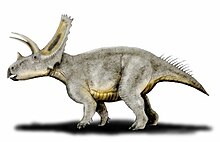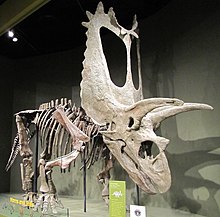Titanoceratops
| Titanoceratops Temporal range: Late Cretaceous,
| |
|---|---|

| |
| Closeup of the unrestored region of the skull | |
| Scientific classification | |
| Domain: | Eukaryota |
| Kingdom: | Animalia |
| Phylum: | Chordata |
| Clade: | Dinosauria |
| Clade: | †Ornithischia |
| Clade: | †Neornithischia |
| Clade: | †Ceratopsia |
| Family: | †Ceratopsidae |
| Subfamily: | †Chasmosaurinae |
| Tribe: | †Triceratopsini |
| Genus: | †Titanoceratops Longrich, 2011 |
| Type species | |
| †Titanoceratops ouranos Longrich, 2011
| |
Titanoceratops (meaning "titanic horn face") is a genus of herbivorous ceratopsian dinosaur. It was a giant chasmosaurine ceratopsian that lived in the Late Cretaceous period (Campanian stage, about 75 million years ago[1]) in what is now New Mexico. Titanoceratops was named for its large size, being one of the largest known horned dinosaurs and the type species was named T. ouranos, after Uranus (Ouranos), the father of the Greek titans. It was named in 2011 by Nicholas R. Longrich for a specimen previously referred to Pentaceratops. It is the oldest known member of Triceratopsini.
It is known solely from the holotype OMNH 10165, a partial skeleton including a mostly complete skull and jaws, and much of the skeleton. The reconstructed skull measures 2.65 metres (8.7 ft) long, making it a candidate for the longest skull of any land animal. With an estimated weight of 6.55 tonnes (6.45 long tons; 7.22 short tons) and length of 6.8 metres (22.3 ft), Titanoceratops compares with the giant Torosaurus and Triceratops, and was the largest animal in its ecosystem, if not in North America.
The holotype skeleton, OMNH 10165, was found in the upper Fruitland Formation, or the lower Kirtland Formation. The border between the two formations is bold, but the original quarry is lost, so it is not known which formation Titanoceratops comes from. The formations are both late Campanian in age.
Discovery and naming


The holotype of Titanoceratops was collected from the upper Fruitland Formation or the lower Kirtland Formation in July 1941, by a field crew consisting J. Willis Stovall, his student Wann Langston Jr., and Donald E. Savage.[2] The precise location of the quarry is no longer known. The holotype specimen consists of most of the fore and hindlimbs, some vertebrae, a fairly complete skull with only one small section of the frill, and partial lower jaws.[3] The bones, being preserved in a fine-grained shale, were crushed and fragile, and so the skeleton was initially considered unsuitable for mounting. Later, however, the fossils were prepared and the skeleton put on display at the Oklahoma Museum of Natural History. In 1998, the specimen was described by Thomas Lehman as an aberrant and unusually large individual of Pentaceratops sternbergii, previously described from the same area.[2] However, Lehman noted a number of unusual features of the skull that were more similar to Triceratops than to Pentaceratops. The species was later reinterpreted as a member of the Triceratopsini, the group including Triceratops, and formally named by Nicholas R. Longrich in 2011 and the type species is Titanoceratops ouranos.
Named by Longrich, Titanoceratops is derived from the Greek Titan, a mythical race of giants, keras (κέρας), meaning "horn", and ops (ὤψ), "face". The species name ouranos, refers to Uranus, the father of the Titan race.[3]
Description


The skull measures 1.2 m (3.9 ft) from the tip of the snout to the quadrate, and the restored frill extends its length up to 2.65 m (8.7 ft)[3] making it a candidate for the longest skull of any land animal. Titanoceratops was as large as the later triceratopsins Triceratops and Torosaurus, with an estimated weight of 6.55 tonnes (7.22 short tons)[3] and a mounted skeleton measuring 6.8 metres (22.3 ft) long and 2.5 metres (8.2 ft) tall at the back.[2] In 2016 Gregory S. Paul gave a lower estimation of 6.5 meters (21.3 ft) and 4.5 tonnes (4.9 short tons). Tom Holtz (2012) noted that it is extremely similar to its closely related contemporaries Eotriceratops and Ojoceratops, which may all be synonymous.[4] The holotype skeleton of Titanoceratops consists of a partial skull with jaws, syncervical, cervical, dorsal, and sacral vertebrae, caudal certebrae, ribs, humeri, a right radius, femora, tibiae, a right fibula, both ilia, both ischia, and ossified tendons.[3] In total, the amount of material assigned to Titanoceratops means it is quite well known, along with genera like Triceratops, Vagaceratops, Pentaceratops, Chasmosaurus, Centrosaurus, Styracosaurus, and Anchiceratops.[5]
Classification
Originally assigned to Pentaceratops, Titanoceratops was found by Longrich in its description to not be closely related to that taxon, and instead found it to share characteristics with Triceratops and Torosaurus, for while Longrich established the clade Triceratopsini. The skeleton has many derived features that are shared between Triceratops and its closest relatives.[3] Although the author that originally assigned it to Pentaceratops has decided to ignore this in subsequent publications,[6] most recent studies find Titanoceratops to be valid and distinguished from Pentaceratops.[3][7][5]
The below cladogram follows Longrich (2015), who named a new species of Pentaceratops, and included nearly all species of chasmosaurine.[8]
| Chasmosaurinae |
| |||||||||||||||||||||||||||||||||||||||||||||||||||||||||||||||||||||||||||||||||||||||||||||||||||||||||||||||||||||
Distinguishing characteristics


Titanoceratops was provided with a list of characters found by Longrich in its description that differ it from other taxa. The features below distinguish it from other Chasmosaurines: the possession of thin squamosals (Triceratops); an unsealed parietal fenestrae (Triceratops); an epijugal resembling a hornlike structure (Triceratops); a narrow median bar of the parietal (Triceratops, Torosaurus); a narial strut oriented vertically with a narrow base (Triceratops, Torosaurus); an enlarged epoccipital on the rear end of the squamosal (Triceratops, Torosaurus, Eotriceratops); an extremely enlarged premaxillary fossa (Triceratops, Torosaurus, Eotriceratops); and in lacking a narial process of the premaxilla that is dorsally inflected (Triceratops, Torosaurus, Eotriceratops).[3]
Paleoecology

Titanoceratops is known from OMNH 10165, a skeleton from the lowermost Fruitland or uppermost Kirtland Formation. The Fruitland Formation is about 100 metres (330 ft) thick, and consists of sandstones, mudstones, and abundant coals deposited in a coastal floodplain. Fossil trees are abundant in the area from which the holotype was collected, suggesting a wet, well-forested environment.

The Kirtland Formation, which conformably overlays the Fruitland, is approximately 600 metres (2,000 ft) thick, and made up of sandstone, siltstone, mudstone, and shale. Both formations are late Campanian in age. The Fossil Forest Member of the Fruitland is 74.11 ± 0.62 million years old, and the Hunter Wash Member of the Kirtland is between 73.37 ± 0.18 and 73.04 ± 0.25 million years in age. The two members combined make up the Hunter Wash local fauna. Therefore, Titanoceratops dates between 74 and 73 million years ago.[3] The age Titanoceratops lived in is called the Kirtlandian land-vertebrate age, and it is characterized by the appearance of Pentaceratops sternbergii.[9]
A moderately diverse fauna is known from the Kirtland and Fruitland formations.[3] Among the dinosaurs known from the Fruitland and Kirtland formations are the theropods Bistahieversor sealeyi (previously Daspletosaurus and Albertosaurus sp.[9]), "Saurornitholestes" robustus, Paronychodon lacustris,[9] and an indeterminate ornithomimid (previously Ornithomimus antiquus[9]); the hadrosaurids Anasazisaurus horneri and Parasaurolophus cyrtocristatus; the pachycephalosaur Stegoceras novomexicanum (previously S. validum);[10] the ankylosaur Nodocephalosaurus kirtlandensis; and the ceratopsians Pentaceratops sternbergii and an unidentified centrosaurine.[3]
Non-dinosaurian fauna include the fishes Myledaphus bypartitus, and Melvius chauliodous; the turtles Denazinemys ornata, Denazinemys nodosa, Boremys grandis, Neurankylus baeuri, Adocus bossi, Adocus kirtlandicus, Basilemys nobilis, Asperideretes ovatus, "Plastomenus" robustus, and Bothremydidae n. gen., barberl; the crocodylians Denazinosuchus kirtlandicus, Brachychampsa montana, Deinosuchus rugosus, and Leidyosuchus sp.; and the mammalians Paracimexomys judithae, Mesodma senecta, Mesodma sp., Cimexomys sp., Cinemoxys antiquus, Kimbetohia campi, Cimolodon electus, Meniscoessus intermedius, Essonodon sp., Alphadon marshi, Alphadon wilsoni, Alphadon sp. A, Alphadon sp. B, Alphadon? sp., Pediomys cooki; Gypsonictops sp., Cimolestes sp., and an indeterminate eucosmodontid.[9]
Biogeography
Previously, the origins of Triceratops were poorly known. Until the description of Titanoceratops, Eotriceratops was the oldest known triceratopsin, and only dated to 68 million years old, from the uppermost region of the Horseshoe Canyon Formation. No Campanian triceratopsins were known, so it appeared as if the group evolved in the Maastrichtian. Titanoceratops shows that large-bodied ceratopsians evolved millions of years earlier than thought. Based on the age of Titanoceratops, there must have been a five million year ghost lineage leading to Eotriceratops.[3]
Titanoceratops supports the idea that late Cretaceous dinosaur faunas were highly endemic, with distinct species found in the Southern Great Plains of New Mexico, and the Northern Great Plains of Montana and Canada. Despite extensive sampling to the north in the Dinosaur Park Formation and Two Medicine Formation, triceratopsins are unknown there. This implies that the triceratopsins originally evolved in the south, then spread north in the Maastrichtian.[3]
See also
References
- ^ Fowler, D. W. 2017. Revised geochronology, correlation, and dinosaur stratigraphic ranges of the Santonian-Maastrichtian (Late Cretaceous) formations of the Western Interior of North America. PLoS ONE 12(11): e0188426.
- ^ a b c Lehman, Thomas M. (1998). "A Gigantic Skull and Skeleton of the Horned Dinosaur Pentaceratops sternbergi from New Mexico". Journal of Paleontology. 72 (5). JSTOR 1306666.
- ^ a b c d e f g h i j k l m Longrich, N.R. (2011). "Titanoceratops ouranos, a giant horned dinosaur from the Late Campanian of New Mexico" (PDF). Cretaceous Research. 32 (3): 264–276. doi:10.1016/j.cretres.2010.12.007.
- ^ Holtz, T.R. Jr. (2012). Dinosaurs: The Most Complete, Up-to-Date Encyclopedia for Dinosaur Lovers of All Ages. Random House Books for Young Readers. p. 432. ISBN 978-0-375-82419-7.
- ^ a b Dodson, P. (2013). "Ceratopsia increase: history and trends". Canadian Journal of Earth Sciences. 50 (2013): 294–305. doi:10.1139/cjes-2012-0085.
- ^ Wick, S.L.; Lehman, T.M. (2013). "A new ceratopsian dinosaur from the Javelina Formation (Maastrichtian) of West Texas and implications for chasmosaurine phylogeny". Naturwissenschaften. 100 (2013): 667–682. doi:10.1007/s00114-013-1063-0. PMID 23728202.
- ^ Naish, D. (2013). "New perspectives on horned dinosaurs: the Royal Tyrrell Museum Ceratopsian Symposium". Historical Biology: An International Journal of Paleobiology. 25 (1): 121–124. doi:10.1080/08912963.2012.688589.
- ^ Longrich, N. R. (2014). "The horned dinosaurs Pentaceratops and Kosmoceratops from the upper Campanian of Alberta and implications for dinosaur biogeography". Cretaceous Research. 51: 292–308. doi:10.1016/j.cretres.2014.06.011.
- ^ a b c d e Lucas, S.G.; Sullivan, R.M., eds. (2006). "The Kirtlandian Land-Vertebrate "Age"-Faunal Composition, Temporal Position, and Biostratigraphic Correlation in the Nonmarine Upper Cretaceous of Western North America". Late Cretaceous vertebrates from the Western Interior (PDF). Vol. 35. New Mexico Museum of Natural History and Science Bulletin. pp. 7–23. Archived from the original (PDF) on 2009-01-05.
{{cite book}}: Unknown parameter|authors=ignored (help) - ^ "Re-evaluation of the Pachycephalosaurids from the Fruitland-Kirtland Transition (Kirtlandian, Late Campanian), San Juan Basin, New Mexico, with a Description of a New Species of Stegoceras and a Reassesment of Texacephale langstoni" (PDF). New Mexico Museum of Natural History and Science, Bulletin. 53: 202–213. 2011.
{{cite journal}}: Unknown parameter|authors=ignored (help)




